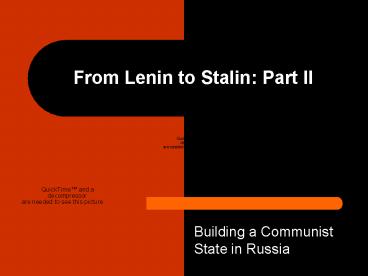From Lenin to Stalin: Part II - PowerPoint PPT Presentation
1 / 23
Title:
From Lenin to Stalin: Part II
Description:
Title: From Lenin to Stalin Author: jurgemeyerja Last modified by: MVHS Created Date: 3/3/2003 11:08:17 PM Document presentation format: On-screen Show – PowerPoint PPT presentation
Number of Views:99
Avg rating:3.0/5.0
Title: From Lenin to Stalin: Part II
1
From Lenin to Stalin Part II
- Building a Communist State in Russia
2
Goals of Lenin
- The goal was to build a CLASSLESS society in
which the means of PRODUCTION were in the hands
of the Russian people - Once the Civil War was over, Lenin could now
focus on rebuilding the nation
3
Civil War 3 year war 1918-1921
- It was between the Reds Communists versus the
Whites tsarist imperial officers. - Allies intervened to help the Whites. Why?
- Reds appealed to nationalism and urged Russians
to drive out foreigners.
Counter Revolutionaries shot the Tsar And the
Tsarina. (Whites July 1918)
4
Results of World War I Communism
- Economy nearly collapsed
- Factory and mine output fallen
- Peasants stopped producing because they knew it
would all go to the government - 5 million die in the Revolution/ 3 million from
Civil war / 2 million from disease / 5 million
from lack of seeds to plant for the next season
10 million
5
Communist Constitution, 1922
- Set up an elected legislature called the Supreme
Soviet - Any person over 18 could vote
- All political power, resources, and means of
production belonged to the PEOPLE. - Communists had the FINAL SAY
6
NEP- New Economic Policy 1921
- Lenin answers the economy by coming up with the
NEP - State controlled banks, foreign trade, large
industries - Small businesses allowed to operate for private
profit - Peasants held onto small plots of land and could
SELL surplus!
7
Results of NEP
- Compromise with Capitalism
- Allowed for
- Russias economy to recover
- Ended armed resistance to new government
- By 1928, food and industrial production was back
to pre-WWI levels
What happens to Lenin? May 13th, 1924
8
White army will kill him for autocracy
9
Lenin Gets SHOT! April 30, 1918
- A lady will approach Lenin and shoot him 3 times.
- Once in the arm, second in the jaw and neck,
third bullet missed him. - The took him to his apartment and left the
bullets in him for a slow recovery. - April 24, 1922 they removed the bullet in his
neck. - He will have headaches and 3 strokes.
10
Power Struggles for Communist Leaders
- Leon Trotsky
- Brilliant Marxist Thinker
- Skillful Public Speaker
- Architect of Revolution
- Joseph Stalin
- Not a Scholar
- Not a Skilled Orator
- Shrewd Political Operator
- Behind-the-Scenes Organizer
Led the Red army during Revolution
11
Leon Trotsky
- Firm Marxist who wanted support for world-wide
revolutions against Capitalism - Isolated by Stalin
- Exiled in 1929
- Murdered in Mexico by a Stalinist agent in 1940
with an ice pick to the head.
12
Joseph Stalin, Man of Steel
- History of prison and Siberian exile
- Not an important role in the Revolution and Civil
War - 1920s, Elected General Secretary of the Communist
Party - Lenin warned the party about Stalin.
comrade Stalin has concentrated enormous power
in his hands and I am not sure that he always
knows how to use that power with sufficient
caution.
13
The Soviet Union under Stalin
- Part II
14
Five Year Plan
- Plan to turn Russia into a modern industrial
power - 1928 Industrial Revolution of sorts
- Build Heavy Industry
- Improve Transportation
- Increase Farm Output
- All Economic Activity under Govt Control
15
Results of 5 Year Plans
- High goals
- Gave bonuses to those who met goals, punished
those who did not (Siberia). - 1928-1939
- Large factories, hydroelectric power stations,
huge industrial complexes - Oil, coal, steel production increased
- New Railroads
16
Effects on People
- Overall, Russians had little to show
- Standards of living remained poor, wages low
- Scarce availability for consumer goods
- Large quantities but low quality
- Focus on Heavy Industry
17
Agricultural Revolution
- Stalin forced peasants to give up their land to
live on state-owned farms - Collectives Large farms owned and operated by
group of peasants - State set prices and controlled access to farm
supplies
18
Goals of Collectives
- Provide tractors, fertilizers, better seeds
- Teach peasants modern farm methods
- Surplus grain was also sold abroad to earn to
invest
19
Resistance
- Peasant resisted by
- Killing farm animals
- Destroying tools
- Burning crops
- Government responds
- with brutal force
20
Kulaks and Labor Camps
- Wealthy peasants, Kulaks, were rounded up.
- Sent to labor camps
- Govt confiscated their lands and cattle of
peasants - Thousands died from labor or were killed
21
Labor Camp
22
Effects of Collectivization
- Peasants grew just enough so govt seized all
grainleaving people to starve - Poor harvests and govt action led to famine
- 5-8 million people died as a result
- Did not improve farm output
- Increased Stalins control
23
The END!
- Soviet Union Symbol































